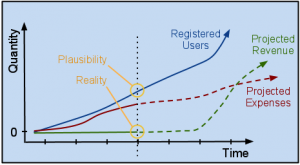With a significantly reduced cost of doing business, compared to traditional brick and mortar upstarts, the software as a service business has leveraged the “free” model of doing business. While powerful in its ability to create service exposure, this model is also the death knell of startups that miss that “free customers” are not, in fact, customers but rather beneficiaries.
“The demand you get at the price of zero is many times higher than the demand you get at a very low price.”
~ Kartik Hosanager, Wharton
Customers as Beneficiaries?
Startups and edge outs always begin with enthusiasm and the best intentions. Unfortunately there is a trap – the notion that one can determine if a market exists by offering something at no cost; let us call it, the Plausibility Postulate. The first trap is often web site visitors or register users being an indication of product or service viability. For new services it can be lots of positive feedback to one’s offering. There is a corollary to the Plausibility Postulate – the startup believes an amassed user following of their free product shall, in some significant percentage, willingly convert to paying customers. With the service offering – one can often confuse working opportunities in one’s network with positive verbal feedback in the network as validating the service. While much of this article applies to services, the remainder will be written in regards to product offerings.
It may seem odd to consider users as beneficiaries. A foundational principle of capitalism: a customer gives money to a seller for a product or service which the buyer perceives to be of equal or greater value. Without the monetary exchange there can be no measure of the product or service economic value. In the free use model, one can certainly measure the free activations or time commitment in use of the service as a weak indication of value; given payment is ultimately necessary, it is impossible to correlate free to not so free. As a result, “free customers” not customers. Rather, beneficiaries.
The Plausibility Postulate
 Software as a Service (SaaS) and Freemium startups can easily fall into the trap of considering free customers an early indicator of product value. On the chart to the left, one can easily see that the growth curve of registered users can give the false sense that value exists to be monetized. Beyond the question of whether there is an ultimate paying market, why is the free customer trap a concern?
Software as a Service (SaaS) and Freemium startups can easily fall into the trap of considering free customers an early indicator of product value. On the chart to the left, one can easily see that the growth curve of registered users can give the false sense that value exists to be monetized. Beyond the question of whether there is an ultimate paying market, why is the free customer trap a concern?
Any new upstart has a period of time, often called a runway, where the product or service is funded by an investor. Investors come in many flavors – bootstrappers, angels, venture capitalists or an existing business investing revenue from profitable products into a new offering. The investment of funds creates a window of time to stand up the product and begin the search for paying customers. A successful business, by definition, is one that has found a paying market for its product or service. Anything short of that is simply not a business concern. Even non-profit businesses must find customers – those willing to fund their endeavor.
Find Paying Customers
So the game is not about developing a product or service, though that is a prerequisite for entering the game. Nor is the game about finding free customers beneficiaries. Finding paying customers that lead to a paying market is the mission. As well one needs to determine a business model that effectively mates the customers with the service offering. That funded runway is critical as it becomes the foot race for attempting to sell one’s product – that is reconciling where the market is for which product and finally, which business model will mate them. Some times the feedback drives one to a new market. Or a fundamentally different product or service. Or a different business model. Such pivots will take take up valuable (but necessary) time on the runway.







You must be logged in to post a comment.